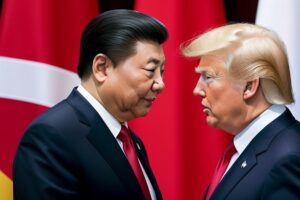Washington, D.C. — Former President Donald Trump’s proposed escalation of tariffs on Chinese goods is sending shockwaves through U.S. businesses that rely on affordable imports, with economists warning of higher prices for consumers and financial strain on small importers.
In a campaign pledge that has gained traction among his political base, Trump has floated imposing tariffs of 60% or higher on Chinese imports—a drastic increase from the rates imposed during his first term. The move, he argues, would protect American manufacturing and punish China for unfair trade practices. But critics say the policy would act as a “sledgehammer” on businesses that depend on low-cost Chinese goods, from retailers to manufacturers.
Importers Brace for the Blow
Small and mid-sized businesses, many still recovering from pandemic-era supply chain disruptions, fear the tariffs could crush profit margins and force price hikes.
“This isn’t just about big corporations—it’s about small businesses that can’t absorb a 60% cost increase overnight,” said Laura Peterson, owner of a home goods import business in Ohio. “Either we pass it on to consumers or go under.”
The National Retail Federation (NRF) has warned that such tariffs would lead to “higher prices on everything from electronics to clothing,” disproportionately affecting lower-income households that rely on affordable imports.
Economic Fallout and Inflation Fears
Economists caution that Trump’s tariff plan could reignite inflation, undoing recent progress in stabilizing prices.
“Tariffs are taxes on American consumers,” said Mark Zandi, chief economist at Moody’s Analytics. “If implemented, these levies would likely push up costs across the board, from raw materials to finished products.”
During Trump’s first term, his Section 301 tariffs on $250 billion worth of Chinese goods led to higher prices for items like bicycles, furniture, and machinery, according to a Peterson Institute for International Economics study. A 60% tariff could be even more disruptive.
Political Divide Over Trade Policy
While Trump’s supporters argue that tough trade measures are necessary to bring manufacturing back to the U.S., opponents say the approach risks triggering a trade war without clear benefits.
President Joe Biden has largely kept Trump’s original tariffs in place but targeted them more selectively, focusing on strategic sectors like semiconductors and clean energy. Biden’s team has also emphasized alliances with other Asian nations to reduce reliance on China.
But with the 2024 election looming, Trump’s hardline stance is forcing a broader debate over how—or whether—to decouple from Chinese supply chains.
What’s Next?
If Trump wins in November and follows through on his tariff plan, businesses could face immediate cost surges, potentially leading to:
- Higher consumer prices on everyday goods
- Supply chain shifts as companies scramble to source from Vietnam, Mexico, or India
- Retaliatory measures from China, possibly targeting U.S. agriculture or tech
For now, importers are bracing for impact. “We survived the first round of tariffs,” said Peterson. “But 60%? That could be the knockout punch.”
— Additional reporting by [Contributor Name].
Would you like any adjustments to focus on specific industries or economic data?
yes please
Trump’s China Tariffs Threaten Retailers, Manufacturers, and Consumers with Soaring Costs
By [Your Name] | [Publication Name] | [Date]
Washington, D.C. — Former President Donald Trump’s proposal to impose 60% or higher tariffs on Chinese goods is setting off alarm bells across U.S. industries, with retailers, manufacturers, and economists warning of price spikes, supply chain disruptions, and potential job losses. The aggressive trade policy, pitched as a way to revive American manufacturing, could instead hammer businesses reliant on affordable imports—and leave consumers footing the bill.
Retailers Fear Price Hikes on Everyday Goods
The National Retail Federation (NRF) estimates that Trump’s proposed tariffs could increase costs on $500 billion worth of imports, hitting everything from apparel and footwear to electronics and home appliances.
- Big-box retailers like Walmart and Target may be forced to raise prices on low-margin goods.
- Dollar stores, which depend heavily on cheap Chinese imports, could see profitability collapse.
- E-commerce sellers on Amazon and Shopify warn that small businesses will struggle to compete.
“This isn’t just a tax on China—it’s a tax on American families,” said Matthew Shay, CEO of the NRF. “Working-class shoppers will feel this the most.”
Manufacturers Face Supply Chain Chaos
While Trump argues that tariffs will bring factory jobs back to the U.S., many manufacturers say the move will raise their production costs without boosting competitiveness.
- Auto parts suppliers warn that tariffs on Chinese components could increase car prices by thousands of dollars.
- Electronics makers fear disruptions in sourcing everything from smartphone parts to industrial machinery.
- Bicycle and furniture industries, already struggling with previous tariffs, say another hike could force layoffs.
“We spent years shifting supply chains after the last tariffs,” said John Henderson, a Michigan-based auto parts manufacturer. “Now, if costs jump 60%, we’ll have to either cut jobs or pass it all to consumers.”
Inflation Risks Loom Large
Economists at Moody’s Analytics and the Peterson Institute for International Economics predict that Trump’s tariffs could:
- Add 1-2% to overall inflation, reversing recent progress on lowering prices.
- Slow economic growth by reducing consumer spending power.
- Trigger retaliatory tariffs from China, hurting U.S. agriculture and tech exports.
“History shows tariffs get paid by U.S. businesses and consumers, not foreign exporters,” said Mary Lovely, a trade economist at Syracuse University.
Political Battle Over Trade Policy
The Biden administration has kept some Trump-era tariffs but focused on strategic sectors like semiconductors and green energy, while pursuing alternate supply chains in Mexico, India, and Southeast Asia.
Trump’s team argues that only extreme pressure will force China to change its trade practices. But critics say a 60% tariff is economic overkill.
“There’s a smarter way to compete with China than just swinging a sledgehammer,” said Sen. Sherrod Brown (D-OH), who supports targeted trade measures but opposes blanket tariffs.
What Happens Next?
If Trump wins in November and implements the tariffs, businesses could face:
✅ Immediate price increases on consumer goods by late 2025.
✅ A rush to relocate supply chains—but with no quick fixes.
✅ Possible trade war escalation, risking U.S. exports.
For now, retailers and manufacturers are stockpiling inventory and scouting alternative suppliers, but many say there’s no easy escape from the fallout.
“This isn’t just about politics—it’s about survival for small businesses,” said Linda Chen, a Texas-based toy importer. “If these tariffs hit, a lot of us won’t make it.”



